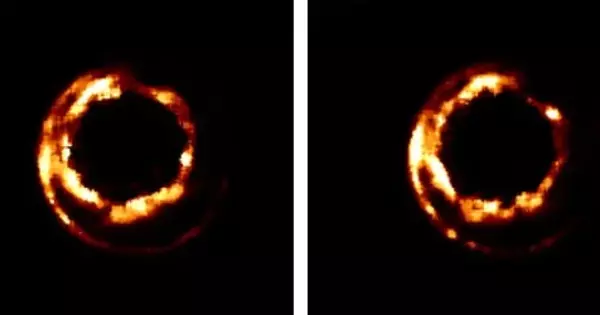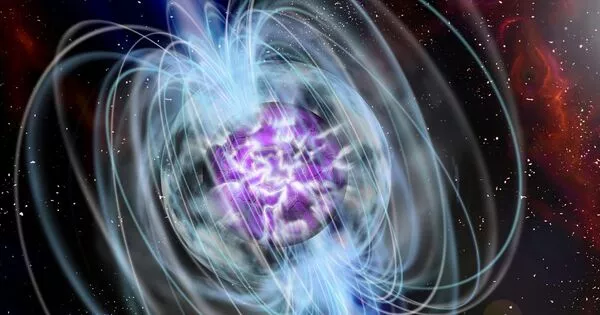Magnetars are a type of neutron star that has an extremely strong magnetic field. These objects are known for their rapid spin, which can slow down over time due to various factors, such as the emission of high-energy particles and magnetic field decay. A recent study proposed a new explanation for the slowdown of magnetars: a volcano-like rupture on the surface of the star. According to the researchers, this type of event could release energy that would cause the star’s spin to decrease.
In October 2020, SGR 1935+2154, a highly magnetic neutron star, abruptly began spinning more slowly. Astrophysicists now believe the magnetar’s rotational slowdown was caused by a volcano-like rupture near its magnetic pole.
On October 5, 2020, the rapidly rotating corpse of a long-dead star about 30,000 light years from Earth changed speeds. Its rotation slowed in a cosmic instant. A few days later, it abruptly began emitting radio waves. Rice University astrophysicist Matthew Baring and colleagues were able to test a new theory about a possible cause of the rare slowdown, or “anti-glitch,” of SGR 1935+2154, a highly magnetic type of neutron star known as a magnetar, thanks to timely measurements from specialized orbiting telescopes.
Baring and colleagues used X-ray data from the European Space Agency’s X-ray Multi-Mirror Mission (XMM-Newton) and NASA’s Neutron Star Interior Composition Explorer (NICER) to analyze the magnetar’s rotation in a study published this month in Nature Astronomy. They demonstrated that the sudden slowdown could have been caused by a volcano-like rupture on the star’s surface, which spewed a “wind” of massive particles into space. The study determined how such a wind could alter the star’s magnetic fields, potentially triggering radio emissions that were later measured by China’s Five-hundred-meter Aperture Spherical Telescope (FAST).
People have speculated that neutron stars could have the equivalent of volcanoes on their surface. Our findings suggest that could be the case and that on this occasion, the rupture was most likely at or near the star’s magnetic pole.
Prof. Baring
“People have speculated that neutron stars could have the equivalent of volcanoes on their surface,” said Baring, a professor of physics and astronomy. “Our findings suggest that could be the case and that on this occasion, the rupture was most likely at or near the star’s magnetic pole.”
SGR 1935+2154 and other magnetars are neutron stars, which are the compact remains of a dead star that collapsed due to intense gravity. Magnetars, which are about a dozen miles wide and as dense as the nucleus of an atom, rotate once every few seconds and have the most intense magnetic fields in the universe.
Magnetars emit intense radiation, including X-rays, radio waves, and gamma rays on occasion. Astronomers can learn a lot about unusual stars from their emissions. Physicists can calculate a magnetar’s rotational period, or the amount of time it takes to complete one complete rotation, as the Earth does in one day, by counting X-ray pulses, for example.
Glitches are abrupt increases in rotational speed that are most often caused by sudden shifts deep within the star, Baring said.

“In most glitches, the pulsation period shortens, implying that the star spins a little faster than before,” he explained. “The textbook explanation is that the star’s outer, magnetized layers slow down over time, but the inner, non-magnetized core does not. This causes stress to build up at the boundary between these two regions, and a glitch indicates a sudden transfer of rotational energy from the faster spinning core to the slower spinning crust.”
Magnetars’ abrupt rotational slowdowns are extremely rare. Only three of the “anti-glitches,” including the October 2020 event, have been observed by astronomers.
While glitches are frequently explained by changes within the star, anti-glitches are unlikely to be. Baring’s theory assumes that they are caused by changes on the star’s surface and in the space around it. In the new paper, he and his colleagues built a volcano-driven wind model to explain the measured results of the October 2020 anti-glitch.
According to Baring, the model accounts for the rotational slowdown using only standard physics, specifically changes in angular momentum and energy conservation. “A strong, massive particle wind emanating from the star for a few hours could establish the conditions for the drop in rotational period,” he said. “Our calculations showed such a wind would also have the power to change the geometry of the magnetic field outside the neutron star.”
The rupture could be a volcano-like formation, because “the general properties of the X-ray pulsation likely require the wind to be launched from a localized region on the surface,” he said.
“What distinguishes the October 2020 event is a fast radio burst from the magnetar just a few days after the anti-glitch, as well as a switch-on of pulsed, ephemeral radio emission shortly thereafter,” he explained. “We’ve only seen a handful of transient pulsed radio magnetars, and this is the first time we’ve seen a magnetar’s radio switch-on almost concurrently with an anti-glitch.”
This timing coincidence, according to Baring, suggests that the anti-glitch and radio emissions were caused by the same event, and he is hopeful that further research into the volcanism model will provide more answers. “The wind interpretation provides a path to understanding why the radio emission activates,” he explained. “It gives us new insights that we didn’t have before.”





